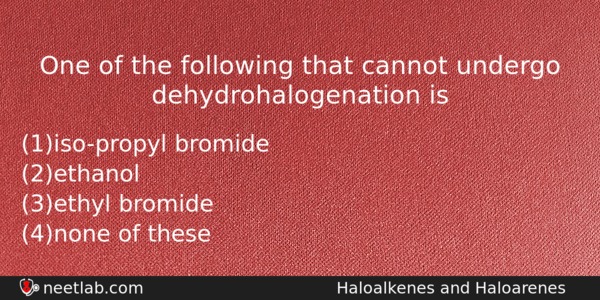| ⇦ | 
| ⇨ |
One of the following that cannot undergo dehydrohalogenation is
Options
(a) iso-propyl bromide
(b) ethanol
(c) ethyl bromide
(d) none of these
Correct Answer:
ethanol
Explanation:
No explanation available. Be the first to write the explanation for this question by commenting below.
Related Questions: - How many coulombs of electricity are required for the reduction of 1 mol
- Mass of one atom of X is 2.66 x 10⁻²³ g, then its 32 g is equal to
- The maximum number of hydrogen bonds formed by a water molecule in ice is
- In the silver plating of copper, K[Ag(CN)₂] is used instead of AgNO₃. The reason
- Polarisation power of a cation increases,when
Topics: Haloalkenes and Haloarenes
(78)
Subject: Chemistry
(2512)
Important MCQs Based on Medical Entrance Examinations To Improve Your NEET Score
- How many coulombs of electricity are required for the reduction of 1 mol
- Mass of one atom of X is 2.66 x 10⁻²³ g, then its 32 g is equal to
- The maximum number of hydrogen bonds formed by a water molecule in ice is
- In the silver plating of copper, K[Ag(CN)₂] is used instead of AgNO₃. The reason
- Polarisation power of a cation increases,when
Topics: Haloalkenes and Haloarenes (78)
Subject: Chemistry (2512)
Important MCQs Based on Medical Entrance Examinations To Improve Your NEET Score
18000+ students are using NEETLab to improve their score. What about you?
Solve Previous Year MCQs, Mock Tests, Topicwise Practice Tests, Identify Weak Topics, Formula Flash cards and much more is available in NEETLab Android App to improve your NEET score.
Share this page with your friends

Leave a Reply